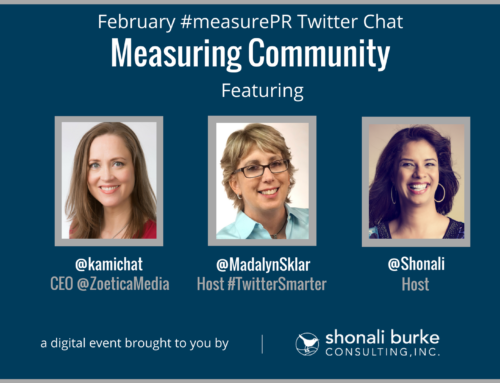 Guest Post by Lisa Gerber
Guest Post by Lisa Gerber
It was 2009. My entire world was focused on recovering from the Great Recession. Heck, I was hoping just to make it through. My PR business (Big Leap Creative) was barely five years old at the time, and I, sadly, had to let my one employee go. It was back to me.
I had taken one step forward, two steps back, and I wasn’t sure how to reverse it.
In hindsight, I was doing OK surviving that period. But “doing OK” wasn’t enough. That’s when I realized while I knew my business well, I didn’t know the business of my business.
I’d like to talk about the decision making process of fixing problems. Some of us are of the mind to go about problem solving. Others wait. Either for someone to come fix it for them, or for it to fix itself. I’m guessing most of us here are of the former mindset.
Often, identifying the precise problem is the first hurdle.
One day the solution fell in my lap. A brochure arrived in the mail, almost as if the Universe was listening. It was a brochure for the PRSA Counselors Academy Spring Conference, a gathering of agency leaders and CEOs with a speaker agenda and attendees discussing the business side of running a PR agency.
I looked at the agenda and found topics on all the things I had questions about – not about practicing PR, but about running a PR business. It spoke to me. This is what I needed.
The only thing is, it wasn’t cheap and I was worried the investment wouldn’t be worth it. This is always the question, isn’t it.
Can you justify the expense of the solution?
I’d hired consultants, and made investments in vast software platforms thinking these would revolutionize my life, only to be disappointed.
Recently, I was on a call with a salesperson vetting hospitality analytics platforms for a client. When I asked how much it cost, she said, “We don’t like to focus on budget, rather, ROI.”
Well that’s all fine and good. But if my client can’t afford the “I”, they sure as hell are not going to be able to enjoy the “R.”
Sometimes, looking at ROI makes sense but in other instances, the R is simply not quantifiable. You can’t quantify the lifetime value of a relationship, or added knowledge.
You could use a divining pendulum like my friend in Santa Monica uses to make her decision at the butcher on what to have for dinner tonight. That seems to work for some people.
You could look at the opportunity cost. If you don’t invest in it, what do you risk? This is always a good one. Perhaps you lose out to your competition. Perhaps you become unable to deliver on something. Perhaps you simply can’t live without it.
But I just have to go on instinct sometimes.
I took that brochure, dogeared and softened with much use, and put it in my briefcase, where it slowly was pushed to the bottom of the bag, further abused, but not forgotten. I told myself I had until April 1 to make the decision. (That was the early registration rate deadline.)
I didn’t try to quantify, didn’t use my divining pendulum, didn’t look at opportunity cost, or even totally obey my instinct. I waited for a sign. And that sign arrived in the end of the month as a new client signing a contract.
Attending Counselors Academy is now a non-negotiable item in my budget because I finally found my place where I can go, meet with now dear friends and share the same challenges and lessons, and best practices.
We solve problems. We empathize and commiserate and celebrate. I simply can’t wait to sit poolside with my girlfriend and talk about scaling business, HR issues, and how to price stuff. Call me a geek if you must.
If you have the same problem as I do, I hope you’ll think about attending this year’s Counselors Academy Spring Conference.
A few more things might entice you:
*Shonali is speaking twice! “Trends, Tech and Training: What Agency Leaders Must Know to Stay Ahead” and “Lights, Camera, Action! Build Your Power and Presence Through Performance”
*It’s in beautiful Laguna Beach, May 3 to 5
*The early registration deadline is April 2, so you have time
Whether Counselors Academy is for you or not, I hope you’ll find a way to fearlessly face the problems you wish to solve and not shy away from the risk involved, be it by way of your divining pendulum, your instinct, a sign from the universe or in-depth analysis.
If you have a method to add, I’d love to hear about it in the comments below.
Image: Sunny Studio via Shutterstock, Standard License issued to Lisa Gerber
 Lisa Gerber is founder of Big Leap Creative, an integrated communications firm, working virtually with businesses around the globe from her mountain headquarters in Idaho. She blogs about marketing and balancing ambition with happiness. She does her best creative problem-solving out on the trail with her black lab setting a mean pace.
Lisa Gerber is founder of Big Leap Creative, an integrated communications firm, working virtually with businesses around the globe from her mountain headquarters in Idaho. She blogs about marketing and balancing ambition with happiness. She does her best creative problem-solving out on the trail with her black lab setting a mean pace.
![[EVENT]: PR Hacks for Small Biz (online)](https://shonaliburke.com/wp-content/uploads/2021/06/FB-Ad-1200x800-01-01-01-Copy-500x383.jpeg)




![[How To]: Make Your Twitter Chats Soar](https://shonaliburke.com/wp-content/uploads/2018/01/soaring-bird-692070_1280-500x383.jpg)


JoeWitte Mine used to be: Be really confident; overbook yourself; make endless lists; start having a panic attack; go to sleep out of exhaustion; wake up having dreamed the solution.
I’m only joking a bit. I’m working on eliminating the “overbooking” and “panic attack” bits, and the sleeping is more by choice now, because that’s still where I dream up the solutions!
Lisa Gerber I completely agree on the “spend money to make money” bit; I think it can be confusing deciding where you’re going to spend money, though. I’m trying to get smarter about that. Ultimately, I think the more you are able to say with certainty how you want your business to grow, the better you get at doing that.
Yes, see you soon!
RealSocialShark TYVM for sharing lisagerber guest #WUL post! What’s your method?
jcbjr What exactly is your process? We’d love to know. MarkSBabbitt lisagerber
RenildeDeWit Thanks for sharing lisagerber guest #WUL post! What’s your method?
Agreed Lisa. Here’s my typical methodology:
1) Identify the problems
2) Prioritize (this is hard to do- part of the chess match)
3) Look at budget and resources and amount of pain
4) Start movement (get rolling)
5) Adjust and finalize plan as you go
The Army’s “Troop Leading Procedures” is something worth looking at:
1) Receive the mission (aka, what are you trying to achieve)
2) Issue a warning order (aka, let everyone know what they have to do)
3) Make a tenative plan
4) Start movement (get the ball rolling)
5) Conduct reconnaissance (ie, things will look differently when you start to roll, then what you expected)
6) Complete the plan (ie, now you have the real info, and can solidify your strategy)
7) Issue the complete order (ie, tell people what’s going on)
8) Supervise.. (self explanatory).
Thanks Lisa!
MarkSBabbitt shonali The “method” is one that works for us, one we’ve reflected upon, and revised. It’s one that is habitually used.
jocmbarnett TYVM for sharing lisagerber guest #WUL post!
Shonali And that will likely be the last time I have an employee. I enjoy not being tied down to anything. I like the freedom of working with contractors and working my own schedule, accepting/declining work because I want to or not, not because I have to meet payroll.
It’s always a struggle though – you have to spend money to make money, but how much should you throw at a problem or can you solve it another way, and if you make a big investment, is it going to be the kind of thing that ends up being “the best money you ever spent” or a big bad waste. That’s why I love sharing this story about Counselors Academy. I totally waited for the decision to make itself and it truly was “the best money I’ve spent.” :) see ya soon!!!!!
shonali mmangen prosperitygal ShellyKramer leaderswest #WUL and thank you from me, too. :)
sheconsulting so glad you liked it. Thank YOU. shonali
RobBiesenbach It’s going to be a blast! :) And thanks for sharing my post. shonali caprsa
mmangen prosperitygal sheconsulting ShellyKramer leaderswest Ty for sharing lisagerber guest #WUL post!
At least you HAD one worker. I’m still the only worker here at SBC… I’m just too afraid to take on any more unless I develop up a guide of company that I know will assistance incomes, advantages, etc., for a while to come. But I have also come to understand that I like how I perform, with my exclusive system. So there’s no hurry.
http://fourneaubruleurdegraissez.fr/
At least you HAD one employee. I’m still the only employee here at SBC… I’m just too scared to take on any more unless I build up a book of business that I know will support salaries, benefits, etc., for some time to come. But I have also come to realize that I like how I work, with my virtual network. So there’s no rush.
For me – and this will not come as a surprise to you! – it’s really about what solving that problem would achieve – what’s the end result one’s looking for? And when it comes to running the business, those can be really hard questions to answer. Yes, we need to put food on the table, etc… but if we’re thinking strategically, we’re thinking about the long haul. And that’s hard, not to mention scary. But I’m learning to do it, and not bite off more than I can chew. If the answer doesn’t come to me today, it will… when it needs to, and when I’m ready for it.
See you in May, Lisa, and thank you for a super guest post!